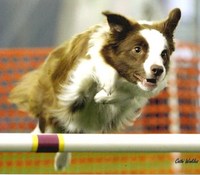Starting dog agility: Common questions answered

Twizzle loving agility!
Debbie Harrison | Contributor
At what age can my dog start agility training? To enroll in a class, most facilities/schools would prefer puppies have had at least their first two sets of puppy shots (check with your own veterinarian for further information), which could be around 12-14 weeks old. If approved by your veterinarian, this is a great time to start agility training. Puppies are just little “learning sponges”; they soak up everything so quickly, but you just need to keep training sessions short to be of the greatest benefit.
Is my dog too old to start agility training? Age is not the lone determining factor for a dog’s ability to start agility training, though the older the dog the more you need to assess their overall health and fitness for the sport. A factor to consider is the dog’s weight — is the dog at an ideal weight, or is he overweight? Certainly overweight dogs can start agility training, and the exercise may well help them slim down, but safety needs to also be exercised in choosing what obstacles and at what height the overweight dog should perform them.
What breeds/types of dogs can train in agility? All breeds can train in dog agility and have fun, from Irish Wolfhounds to Bassett Hounds to Pomeranians! All dogs start learning on downsized equipment and jumps, and, as training/learning progresses, they are “raised up” in relation to the dog’s height. Dog safety is paramount, so close monitoring of obstacle performance is key in determining if and when obstacles should be “raised.”
What do I bring to class? I always tell students to bring a hungry dog on a buckle collar and six-foot leash and plenty of soft, high-value treats. Other types of training collars (head halters, chokes, prong, etc.) may be acceptable in special circumstances; these are reviewed on a case by case basis.
Does my dog have to take obedience classes prior to taking agility classes? It is not absolutely necessary to take obedience classes first but, if you have a dog that will come when called, stay with you, sit, down and stay — you will be much better prepared to enjoy agility training. If your dog does not have these skills then they will start agility classes on leash and as they are trained they can eventually be off leash.
What agility class should I take? You will want to start in some sort of “Introduction to Dog Agility” or “Foundations/Fundamentals for Dog Agility” class. Some of the initial concepts taught to the dogs are very instrumental to their safety. For example, rear end and overall body awareness is absolutely key in keeping the dog happy, healthy and safe on the equipment, and you will always want introductions to the equipment to be smooth, positive and safe. both of these things should be addressed in these types of entry level classes.
I'll be happy to answer any other questions that you might have, so feel free to leave them in the comments section.
Debbie Harrison is a community contributor on AnnArbor.com's pet section and entered the world of agility in 1992. She has since loved, trained and competed with two Dalmatians, two Jack/Parson Russell Terriers and three Border Collies in several dog sport disciplines. She is owner of Agility Synergy LLC in Ann Arbor. Contact her via email.

